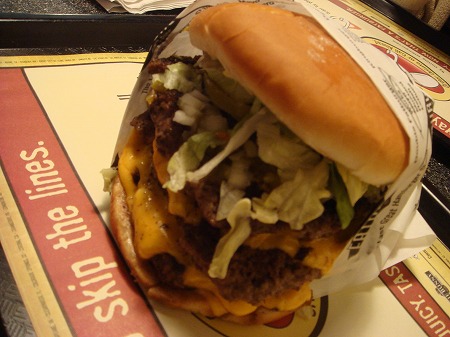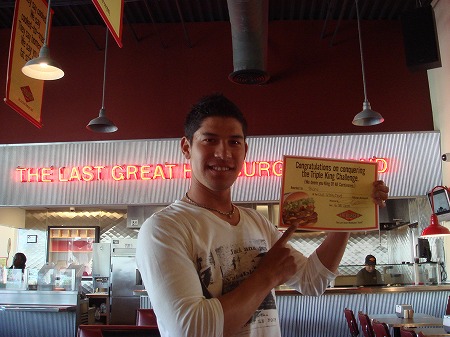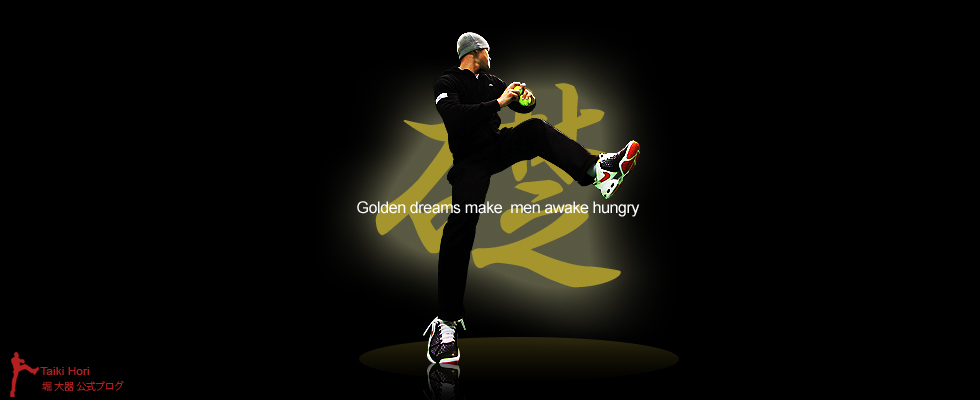

残念ながら昨日、IFT$50,000のベスト8で負けてしまいました。とても惜しい試合だったので悔しいですね。応援ありがとうございました!
さて、今日はアメリカで有名なハンバーガー屋さんで、1952年からオープンしている”Fatburger”に一番大きいサイズのバーガーにチャレンジ!とにかく重さ、大きさに圧倒されて、最後まで食べられるか心配だったけど、無事完食!!そして賞状までもらいました!
「FAT」という名前にすることで知名度がグンとアップしていることは言うまでもないのですが、英語の「FAT」には「太った」という意味以外にも、「裕福な」や「豊かな」といった意味もあるのです。更には肉などを指す場合は、「最も良い部分」を指すこともあるそうです。調べたところ、ファット・バーガーは一番健康的な素材を使用していることが分かり、素材にこだわっているそうですよ!
それにしても、約1kgのバーガーを食べてしまう自分が怖いです。店員さんに写真を撮ってもらい店内の壁に張るのでもしクリアウォーターに来られた時には写真をチェックしてみてください!
どっかにいます!!
ファット・バーガーの特徴:
・ハンバーガーは注文してから直火で焼く
・100%高品質の牛肉だけを使用し、冷凍肉などは使用しない
・オニオンリングやフライドポテトも冷凍ではなくその場で調理
・アイスクリームも自家製
・コレステロールゼロの油で調理
当分バーガーは食べたくても大丈夫って感じです!
Advertisements

コメント
試合残念だったね(ーー゛)しかし大器君はハンバーガーとかフロリダとかよく似合うね。ブログ更新楽しみにしてるので、テニスともどもがんばってな!!
大器やったか!
オレはやっぱり断念しました。
では、また。
うぁ~美味そう!!
大器君なら3キロ位は食べれるんじゃない!!
ブログ更新、楽しみにしてます!!
大器くん、お疲れ様です!1kgのハンバーガー、完食しちゃうなんてすごいです(@_@)/
根性ありますね!!
テニス、頑張ってください!!
堀さんへ、
今回、ふくらはぎの痛みをもたれている伊達さんやトレーナーに伝えて伝えていただくコメントしています。
SFベイエリアでMen’s OPEN Top 10クラスの選手のテニスチームのコーチをしているものです。
今回のふくらはぎの痛みですが、痛いほとのストレッチは悪影響かもしれません。以下はRoy Benson(マラソンコーチ)の
文章ですが、下の方の段落(ここ)と記入しているところにその生態学的な説明がされています。
伊達さんは、体力的には十分つけらてきましたので、体の(特に足首、アキレス腱、足から腰まで)の柔軟性(Flexibility)を高くメインテしていくことが、今後良い結果につながると思います。
下にかかれている、ストレッチをすることで、「Economy of Motion」を改善し、同じ力を(同じ重いボールを)最小限のエネルギーと力で打っていくが鍵となると思います。
隆昭
By Roy Benson/Running Journal/May 2006
“True confession time here: after 64 years of aging, after 50 years of running, and after years of not stretching enough, I’m now tighter than a tick on a hound’s ear. Please keep in mind that this month’s coachly wisdom is being addressed to the runner in your writer as much as it is to the Yogi in you. In short, dear readers, pray that I will listen well and heed my own advice. I hope, too, that alert reader Charlie Wimberley of Louisiana will find something useful here since it was his request that I pass along some fresh thoughts on the familiar, and perhaps, tired old topic of stretching.
To start, I’d like to point out that there are two distinct and different reasons to stretch. One is to loosen up as a part of those procedures of warming and “hotting” up that I discussed last month. The other is to actually improve your basic flexibility. The first one is part of getting loose, but not necessarily improving your flexibility, in preparation for a hard workout or a race. The idea is to just prep your muscles to move through a bigger range of motion than your everyday easy recovery and your long runs. To prep your muscles for all the excitement of being stretched, warm them up first with enough easy jogging to get you sweating. Then follow the below instructions so you don’t hurt yourself before the real fun of fast, hard running begins. You really don’t need to stretch before your easy and long runs. The chance of straining a muscle moving through such a short range of motion is virtually nil since no lactic acid (the by-product of anaerobic combustion of glycogen) is produced at such low intensity, aerobic efforts. You should, however, stretch after easy and long runs since you will have temporarily tightened your legs by moving them through such a short range of motion.
The second reason to stretch is to actually improve flexibility. You can do this after your workouts when you’re nice and warm and also by simply doing exercises randomly and independently of your running workout, any time and any where during the day when the great spirit of Yoga moves you.
Before we go any further, let me mention what exercise scientists usually conclude from a search of the literature about stretching and flexibility. First, stretching has NOT been shown to prevent injuries. Second, stretching does seem to help recovery from injuries. You’re probably asking yourself, “How can that be true?” Think like a scientist for a minute as you ask yourself how many runners would volunteer for a study that would try to measure how much stretching it would take to strain a muscle or a tendon. Furthermore, if you do a retrospective study of injuries, how would you isolate stretching from all the other variables known to cause strains, pulls, and/or spasms? On the other hand, once runners are injured, it has not been too hard for medical specialists to divide them into two groups to study the impact of stretching on speed of recovery. The stretching groups usually got better sooner. With that said, I suspect that I’ve now fully opened this can of worms.
(Economy Of Motionについて)
If stretching doesn’t prevent injuries, what does it do? It improves your economy of motion. In this case, think of economy as the amount of oxygen and energy used to perform a given movement. This simply means that with improved flexibility, it’s easier to run at the same speed. If you improve your flexibility a little as a result of a stretching program, it won’t take as much effort to move your legs through the same range of motion because there will be less resistance from the opposing muscles during the stride cycle. On the other hand, at the same effort, you can go faster since improved flexibility will automatically increase the length of your stride.
For example, let’s say that your hamstrings have tightened over the years, thus shortening your stride at a typical 10K racing effort of 85 percent of max. How so? At this constant effort, every time your legs move through one stride cycle, if your quads make this 85 percent effort, the tightness in your hamstrings will limit how far you extend your lower leg prior to foot strike. The result is the classic picture you see when geezers like me run with a pitifully choppy, little stride. On the other hand, if your problem is tight quadriceps, you are in double trouble because they have to be stretched twice during each stride cycle. The first time is when the quads are supposed to relax and stretch as your hamstring muscles contract when they lift your heels towards your butt after your foot pushes off the ground. The second contraction of the hamstrings takes place after your quads have contracted in order to extend your lower leg out in front of you. Then, in order to bring your lower leg back closer to your center of gravity in preparation for foot strike, the hamstrings again have to overcome the resistance of your tight quads. If you are still keeping the racing effort constant at 85 percent, and you are trying to overcome the resistance of tightness in both your quads and hamstrings, the only possible result is an exponential decrease in your pace. Or, if you try to race as fast as you once did, the effort obviously has to increase. But you certainly can’t hold that effort for as long. Now your 5K times are what you used to split on your way to a 10K. Boy oh boy, getting old and tight can be hard on your ego, can’t it?
Since we can’t do much about the declining capacity of our collagen as we age, what can we do to maintain or even improve our flexibility?
(ここ)
Research suggests that stretching can do the job, but with this most important caveat: don’t feel the pain. Why? Because if you stretch that vigorously, you will engage nerves embedded in your muscles that will tell your brain that you are about to do damage. These stretch receptor nerves then cause the muscle to contract in an effort to pull you away from this over-stretched position. If you are determined to fight through the pain, the resulting stretching of a contracted muscle (known as an eccentric contraction) will cause micro- tears in the muscle fiber. Hence the soreness at best, or immobilization at worst, when you injure yourself while trying to be nice to your body. Rather ironic, isn’t it?
To avoid being counter-productive, just take the stretch to the point of discomfort and then concentrate on relaxing for 30 seconds. As an example, try stretching your right calf by standing on a step. With your weight on your left foot, move your right foot back until just the front half is on the step. Then, slowly drop your heel down until you just start to feel the pain of over-stretching as those receptor nerves get irritated. Quickly lift up your heel an inch or two to the spot where you feel just mild discomfort. Now relax and slowly drop your heel again and stretch your calf until you reach the first sign of pain. Lift up again and then relax through an extended range of motion. Repeat this for 30 seconds and you will realize a significant improvement over the position where you first felt the pain of over-stretching. Do this exercise three times per session. Do it several times per week and you will notice that you can drop your heel much lower before you engage the stretch receptor nerves.
SFエリアにこられることがあれば連絡くださいね!
売れてるからって「天狗」になってる感もないから
まぁ片想いであれば自分はシーズンで終わっちゃいそうですねパンダ